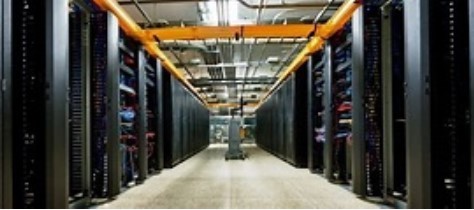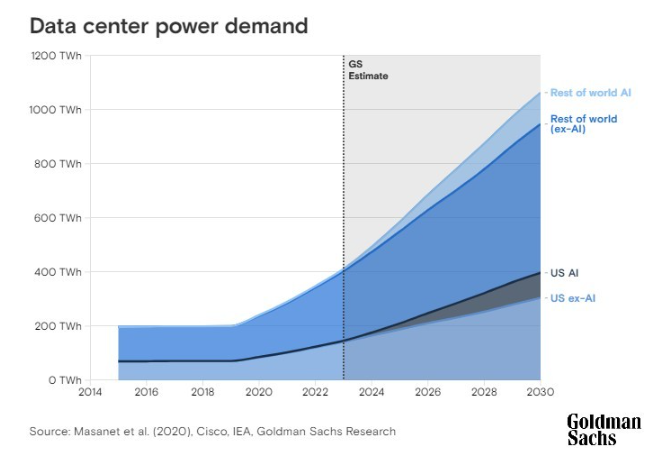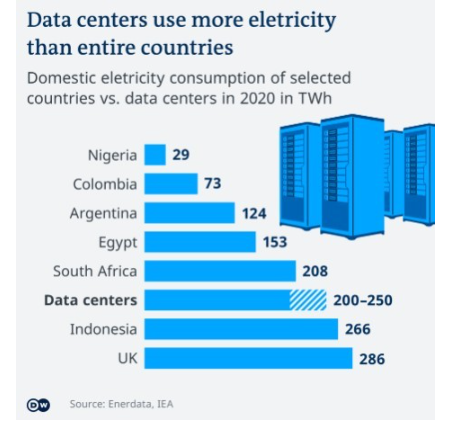
ENB Pub Note: I had the pleasure of interviewing Ron Miller on the podcast, and here is one of his outstanding articles. I highly recommend following him on Linkedin.
The U.S. and the world are using innovative technologies such as Artificial Intelligence (AI) to use data more efficiently, along with an increasing demand for electricity. This article will describe the upcoming data center electricity supply shortfall, and potential train wreck in the U.S.
Current Data Center Electricity Demand:
Globally, data centers consume 1-2% of overall energy, and this share will rise to 3-4% by 2030. With this increased electricity demand, the carbon dioxide emissions of data centers may more than double between 2022 and 2030.
In a series of three reports, Goldman Sachs Research analysts have laid out the U.S., European, and global implications of this spike in electricity demand, as shown in Figure 1. The graph shows electricity demand in terawatt-hours (TWh) for data centers without the AI component, and the AI electricity component separately.
Figure 1 – Global and U.S. Data Center Power Demand, AI Power Demand in TWh


To better appreciate how much electricity global data centers use, Figure 2 demonstrates data center demand vs. the electricity demand of several countries on the globe.
Figure 2 – Domestic electricity consumption of selected countries vs. Data Centers in 2020 in TWh


Fueling this rapid rise in electricity demand, a common use example compares the 2.9 watt-hours of electricity required for a single ChatGPT query vs. the 0.3 watt-hours for a Google search, according to the IEA, or a multiple of 10 times more energy.
Although AI innovations are boosting computation speeds faster than electricity’s increased use, the higher use of AI will raise the consumption of power.
From 2015 to 2023, the U.S. electricity demand from data centers grew from 197 to 411 TWh, or at an annual growth rate of 9.63%. However, the dramatic growth has been from 2019 to 2023, from 200 to 411 TWh, or at an annual rate of 19.7%, doubling every 3.65 years, as shown in Figure 3.
Figure 3 – U.S. Data Center Power Demand & Compute Instances 2015-2023

Higher U.S. Electricity Use:
During the last decade, U.S. power demand growth has been negligible, although the population and economic activity have increased. That is about to dramatically change in the future, from now through 2030.
Drivers for this increase in electricity demand will be electrification, industrial reshoring, and data centers.
Currently, data centers consume ~2.5% of electricity demanded in the U.S, and based on the 2022 U.S. demand of 4.07 trillion kWh, they consumed about 0.102 trillion kWhs, or 102 million megawatt-hours (MWhs) in 2022.
Goldman Sachs Research estimates that between 2022 and 2030, the demand for power will rise roughly 2.4%, and around 0.9 percent points of that figure will be tied to data centers. Data centers will use 8% of U.S. power by 2030, compared with 2.5% in 2022.
With the annual growth rate in electricity consumption by 2030, and the increased share of that consumption attributable to data centers, this yields a 0.037 trillion kWh, or 37 million MWhs of incremental electricity demand for data centers by 2030.
Impact Of Electricity Growth Rates:
The compounded annual growth rate of electricity demand from 2022 to 2030 for data centers is 4.0%.It is the segment with the highest demand growth rate in the country.
Thus, by 2030, the U.S. will need 0.037 trillion more kWh (37 million MWhs) per year just for data centers. For a 1,000 MW nuclear plant with a 90% capacity factor, this translates to 4.7 new nuclear plants that will need to be built by 2030 just to satisfy new U.S. data center electricity demand in that year. Current U.S. nuclear capacity is 94.7 GW.
At an estimated cost of $11.2 million per MW of nuclear capacity, U.S. utilities will need to invest around $52.5 billion in new generation capacity just to support data centers alone.
Building 5% of the current U.S. nuclear capacity in 6 years is truly Mission Impossible. We are already behind in securing enough energy supply to meet this demand.
Summary:
1. From 2015 to 2023, the electricity demand from data centers grew from 197 to 411 TWh, or at an annual growth rate of 9.63%.
2. A more dramatic growth occurred from 2019 to 2023, from 200 to 411 TWh, or at an annual rate of 19.7%, doubling every 3.65 years.
3. Currently, data centers consume ~2.5% of electricity demanded in the U.S., or 102 million megawatt-hours (MWhs).
4. Data centers will use 8% of U.S. power by 2030, compared with 2.5% in 2022.
5. The compounded annual growth rate of electricity demand from 2022 to 2030 for data centers is 4.0%.
6. By 2030, the U.S. will need the equivalent of 4.7 new nuclear plants (5% increase from present fleet), at a capital cost of $52.5 billion.
I welcome your comments and questions, and the opportunity to assist you with your energy questions and concerns. I am the principal at Reliant Energy Solutions LLC, a Professional Engineer, Certified Energy Manager, Renewable Energy Professional, and can be reached at ron@reliantenergysolutions.com . My website is: www.reliantenergysolutions.com
“It is better to debate a question without settling it, than to settle a question without debating it.” Joseph Joubert
You are welcome to review my previous energy articles at the link shown below.
https://www.linkedin.com/in/ronmillerenergyindustryvaluecreator/recent-activity/posts/



